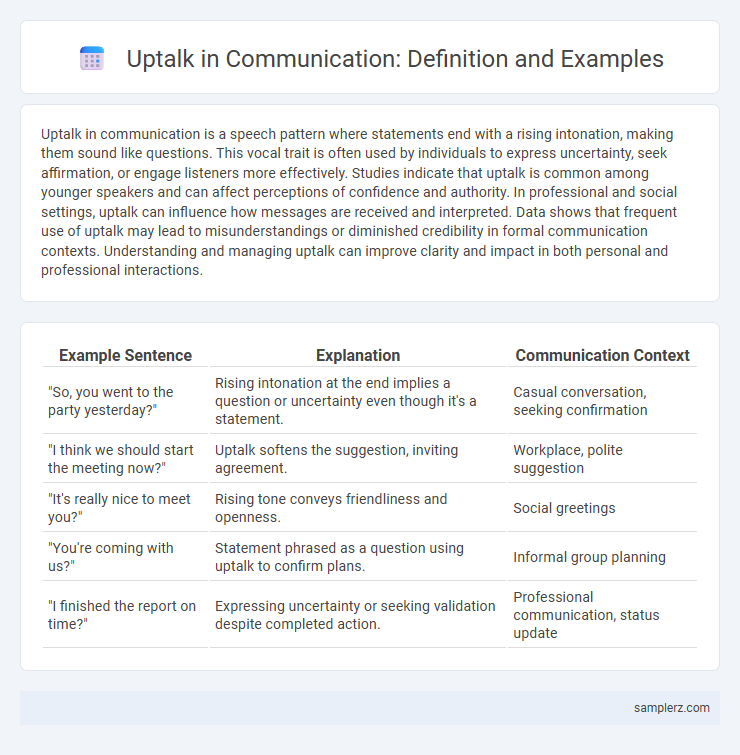Uptalk in communication is a speech pattern where statements end with a rising intonation, making them sound like questions. This vocal trait is often used by individuals to express uncertainty, seek affirmation, or engage listeners more effectively. Studies indicate that uptalk is common among younger speakers and can affect perceptions of confidence and authority. In professional and social settings, uptalk can influence how messages are received and interpreted. Data shows that frequent use of uptalk may lead to misunderstandings or diminished credibility in formal communication contexts. Understanding and managing uptalk can improve clarity and impact in both personal and professional interactions.
Table of Comparison
| Example Sentence | Explanation | Communication Context |
|---|---|---|
| "So, you went to the party yesterday?" | Rising intonation at the end implies a question or uncertainty even though it's a statement. | Casual conversation, seeking confirmation |
| "I think we should start the meeting now?" | Uptalk softens the suggestion, inviting agreement. | Workplace, polite suggestion |
| "It's really nice to meet you?" | Rising tone conveys friendliness and openness. | Social greetings |
| "You're coming with us?" | Statement phrased as a question using uptalk to confirm plans. | Informal group planning |
| "I finished the report on time?" | Expressing uncertainty or seeking validation despite completed action. | Professional communication, status update |
Understanding Uptalk in Modern Communication
Uptalk, characterized by rising intonation at the end of statements, often appears in American English, especially among younger speakers and in customer service interactions. This speech pattern can signal uncertainty or invite engagement, influencing how messages are perceived in both casual conversations and professional settings. Understanding uptalk is essential for interpreting speaker intent and improving communication effectiveness across diverse social contexts.
Common Situations Where Uptalk Appears
Uptalk frequently appears in customer service interactions, where representatives use rising intonation to convey politeness and engagement. In social conversations among young adults, uptalk signals openness and encourages listener participation. Classroom settings with students asking questions or seeking confirmation also commonly feature uptalk as a tool for fostering dialogue.
Uptalk in Professional Settings: Real-Life Examples
Uptalk in professional settings often appears during client presentations when speakers raise their intonation at the end of statements, causing uncertainty about their confidence. For instance, a project manager might say, "The project will be completed by next Friday?" which can lead clients to question the deadline's reliability. This vocal pattern can undermine perceived authority, making clear and assertive communication essential for maintaining professionalism.
Uptalk in Everyday Conversations
Uptalk manifests in everyday conversations when speakers raise their pitch at the end of declarative sentences, creating a questioning tone. This speech pattern often appears in casual settings, such as chatting with friends or giving informal updates, subtly inviting feedback or confirmation. Research indicates that uptalk can enhance social bonding and encourage listener engagement by signaling openness and approachability.
Uptalk Among Teenagers: Illustrative Examples
Uptalk among teenagers frequently appears in everyday conversations, such as when a teen says, "Are we going to the mall?" with a rising intonation at the end, signaling uncertainty or seeking confirmation. This speech pattern often reflects social bonding or a desire for approval within peer groups. Research shows that uptalk can influence perceived confidence levels, affecting how teenage communication is interpreted.
Uptalk and Gender: Sample Dialogues
Uptalk often appears in female speech patterns, exemplified by conversations like, "Are you coming to the meeting?" or "I finished the report, you know?" These rising intonations serve to invite engagement or soften statements, reflecting social dynamics linked to gender communication styles. Research shows that while uptalk is common in women, it also occurs in men, but with differing social implications.
Uptalk on Social Media Platforms
Uptalk on social media platforms is evident when users end statements with rising intonation in videos, livestreams, or voice messages to engage audiences and express enthusiasm. This speech pattern often appears in platforms like TikTok, Instagram Reels, and Snapchat, enhancing relatability and fostering community interaction. The frequent use of uptalk contributes to a conversational tone, encouraging viewer participation and prolonged content engagement.
Uptalk in Public Speaking: Notable Instances
Uptalk in public speaking is prominently observed in TED Talks, where speakers like Emily Levine use rising intonation to engage audiences and create a conversational tone. Politicians such as Alexandria Ocasio-Cortez occasionally employ uptalk to convey approachability and relatability during speeches. This vocal pattern can influence audience perception, balancing professionalism with accessibility in high-stakes communication settings.
Uptalk in Customer Service Interactions
Uptalk in customer service interactions often manifests when representatives raise their pitch at the end of statements, inadvertently signaling uncertainty or a lack of confidence. This vocal pattern can affect customer perceptions, potentially undermining trust and reducing the effectiveness of communication. Training customer service agents to maintain a steady, confident tone enhances clarity and fosters more positive customer experiences.
The Impact of Uptalk: Key Communication Examples
Uptalk, characterized by rising intonation at the end of statements, often causes listeners to perceive speakers as uncertain or less confident, impacting credibility in professional settings. For example, in business meetings, employees who use uptalk may unintentionally undermine their authority, leading to reduced influence and diminished leadership presence. Research shows that mastering intonation patterns improves audience engagement and reinforces message clarity in critical communications.

example of uptalk in communication Infographic
 samplerz.com
samplerz.com